Concetto Spampinato
Zero-Shot Decentralized Federated Learning
Sep 30, 2025Abstract:CLIP has revolutionized zero-shot learning by enabling task generalization without fine-tuning. While prompting techniques like CoOp and CoCoOp enhance CLIP's adaptability, their effectiveness in Federated Learning (FL) remains an open challenge. Existing federated prompt learning approaches, such as FedCoOp and FedTPG, improve performance but face generalization issues, high communication costs, and reliance on a central server, limiting scalability and privacy. We propose Zero-shot Decentralized Federated Learning (ZeroDFL), a fully decentralized framework that enables zero-shot adaptation across distributed clients without a central coordinator. ZeroDFL employs an iterative prompt-sharing mechanism, allowing clients to optimize and exchange textual prompts to enhance generalization while drastically reducing communication overhead. We validate ZeroDFL on nine diverse image classification datasets, demonstrating that it consistently outperforms--or remains on par with--state-of-the-art federated prompt learning methods. More importantly, ZeroDFL achieves this performance in a fully decentralized setting while reducing communication overhead by 118x compared to FedTPG. These results highlight that our approach not only enhances generalization in federated zero-shot learning but also improves scalability, efficiency, and privacy preservation--paving the way for decentralized adaptation of large vision-language models in real-world applications.
Cyst-X: AI-Powered Pancreatic Cancer Risk Prediction from Multicenter MRI in Centralized and Federated Learning
Jul 29, 2025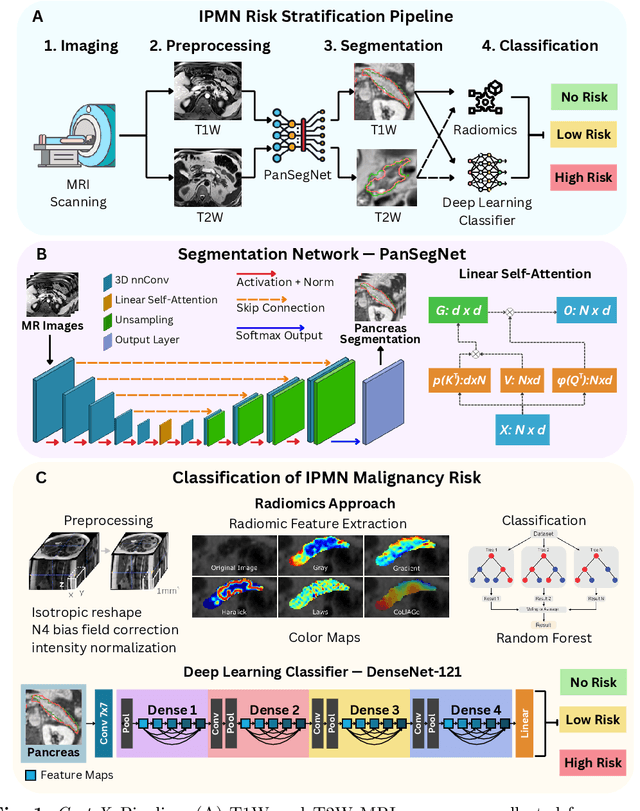

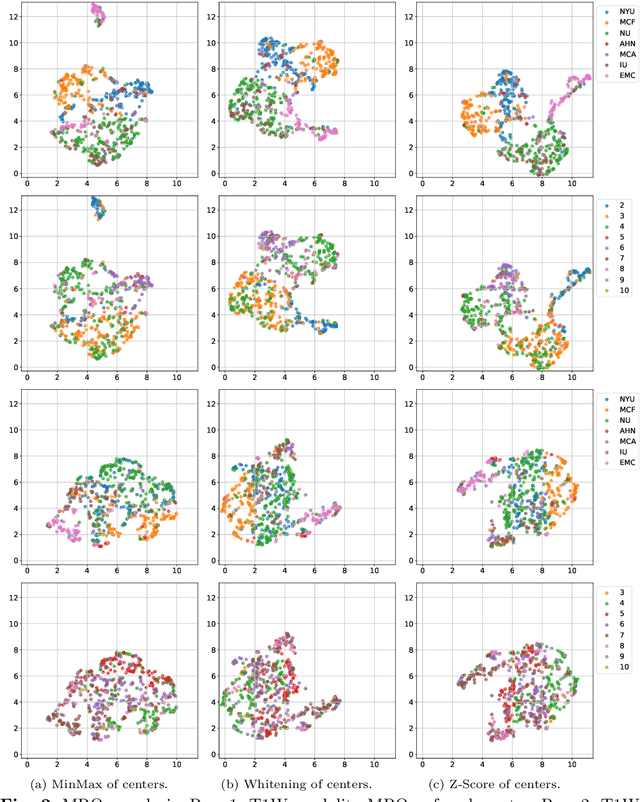
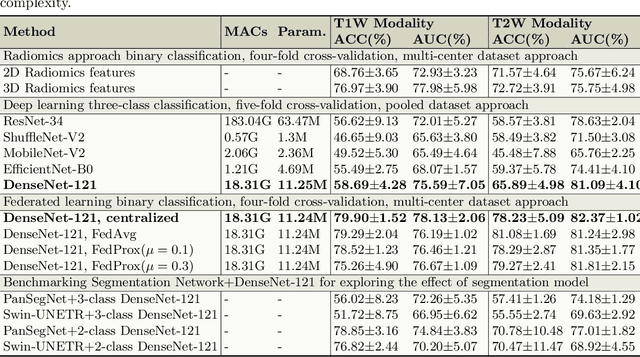
Abstract:Pancreatic cancer is projected to become the second-deadliest malignancy in Western countries by 2030, highlighting the urgent need for better early detection. Intraductal papillary mucinous neoplasms (IPMNs), key precursors to pancreatic cancer, are challenging to assess with current guidelines, often leading to unnecessary surgeries or missed malignancies. We present Cyst-X, an AI framework that predicts IPMN malignancy using multicenter MRI data, leveraging MRI's superior soft tissue contrast over CT. Trained on 723 T1- and 738 T2-weighted scans from 764 patients across seven institutions, our models (AUC=0.82) significantly outperform both Kyoto guidelines (AUC=0.75) and expert radiologists. The AI-derived imaging features align with known clinical markers and offer biologically meaningful insights. We also demonstrate strong performance in a federated learning setting, enabling collaborative training without sharing patient data. To promote privacy-preserving AI development and improve IPMN risk stratification, the Cyst-X dataset is released as the first large-scale, multi-center pancreatic cysts MRI dataset.
QuantFormer: Learning to Quantize for Neural Activity Forecasting in Mouse Visual Cortex
Dec 10, 2024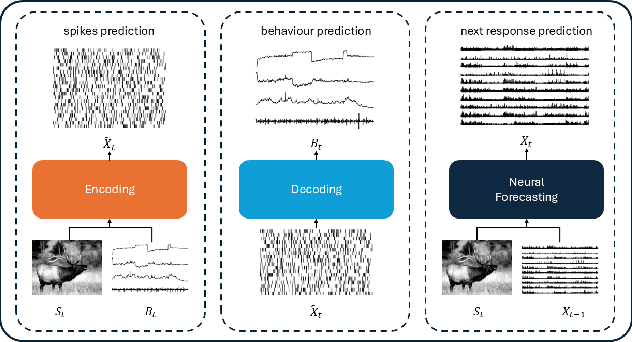
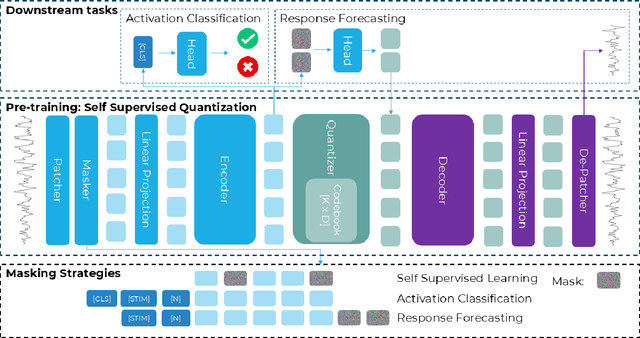
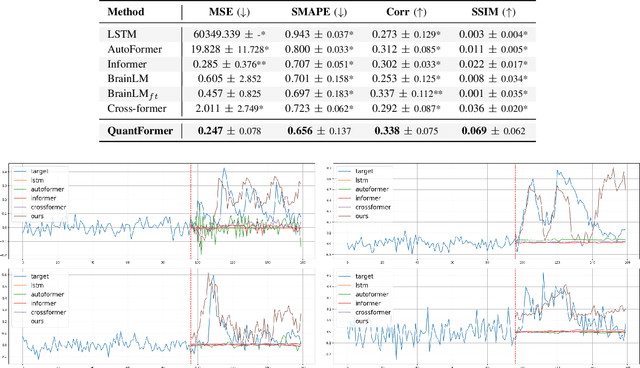
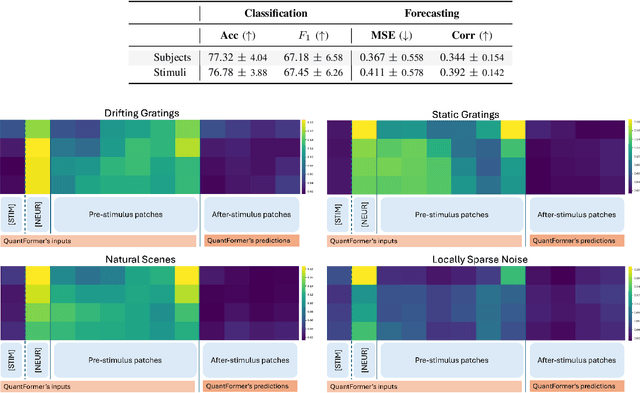
Abstract:Understanding complex animal behaviors hinges on deciphering the neural activity patterns within brain circuits, making the ability to forecast neural activity crucial for developing predictive models of brain dynamics. This capability holds immense value for neuroscience, particularly in applications such as real-time optogenetic interventions. While traditional encoding and decoding methods have been used to map external variables to neural activity and vice versa, they focus on interpreting past data. In contrast, neural forecasting aims to predict future neural activity, presenting a unique and challenging task due to the spatiotemporal sparsity and complex dependencies of neural signals. Existing transformer-based forecasting methods, while effective in many domains, struggle to capture the distinctiveness of neural signals characterized by spatiotemporal sparsity and intricate dependencies. To address this challenge, we here introduce QuantFormer, a transformer-based model specifically designed for forecasting neural activity from two-photon calcium imaging data. Unlike conventional regression-based approaches, QuantFormerreframes the forecasting task as a classification problem via dynamic signal quantization, enabling more effective learning of sparse neural activation patterns. Additionally, QuantFormer tackles the challenge of analyzing multivariate signals from an arbitrary number of neurons by incorporating neuron-specific tokens, allowing scalability across diverse neuronal populations. Trained with unsupervised quantization on the Allen dataset, QuantFormer sets a new benchmark in forecasting mouse visual cortex activity. It demonstrates robust performance and generalization across various stimuli and individuals, paving the way for a foundational model in neural signal prediction.
Self-supervised learning for radio-astronomy source classification: a benchmark
Nov 22, 2024Abstract:The upcoming Square Kilometer Array (SKA) telescope marks a significant step forward in radio astronomy, presenting new opportunities and challenges for data analysis. Traditional visual models pretrained on optical photography images may not perform optimally on radio interferometry images, which have distinct visual characteristics. Self-Supervised Learning (SSL) offers a promising approach to address this issue, leveraging the abundant unlabeled data in radio astronomy to train neural networks that learn useful representations from radio images. This study explores the application of SSL to radio astronomy, comparing the performance of SSL-trained models with that of traditional models pretrained on natural images, evaluating the importance of data curation for SSL, and assessing the potential benefits of self-supervision to different domain-specific radio astronomy datasets. Our results indicate that, SSL-trained models achieve significant improvements over the baseline in several downstream tasks, especially in the linear evaluation setting; when the entire backbone is fine-tuned, the benefits of SSL are less evident but still outperform pretraining. These findings suggest that SSL can play a valuable role in efficiently enhancing the analysis of radio astronomical data. The trained models and code is available at: \url{https://github.com/dr4thmos/solo-learn-radio}
Evidential Federated Learning for Skin Lesion Image Classification
Nov 15, 2024Abstract:We introduce FedEvPrompt, a federated learning approach that integrates principles of evidential deep learning, prompt tuning, and knowledge distillation for distributed skin lesion classification. FedEvPrompt leverages two sets of prompts: b-prompts (for low-level basic visual knowledge) and t-prompts (for task-specific knowledge) prepended to frozen pre-trained Vision Transformer (ViT) models trained in an evidential learning framework to maximize class evidences. Crucially, knowledge sharing across federation clients is achieved only through knowledge distillation on attention maps generated by the local ViT models, ensuring enhanced privacy preservation compared to traditional parameter or synthetic image sharing methodologies. FedEvPrompt is optimized within a round-based learning paradigm, where each round involves training local models followed by attention maps sharing with all federation clients. Experimental validation conducted in a real distributed setting, on the ISIC2019 dataset, demonstrates the superior performance of FedEvPrompt against baseline federated learning algorithms and knowledge distillation methods, without sharing model parameters. In conclusion, FedEvPrompt offers a promising approach for federated learning, effectively addressing challenges such as data heterogeneity, imbalance, privacy preservation, and knowledge sharing.
FedRewind: Rewinding Continual Model Exchange for Decentralized Federated Learning
Nov 14, 2024



Abstract:In this paper, we present FedRewind, a novel approach to decentralized federated learning that leverages model exchange among nodes to address the issue of data distribution shift. Drawing inspiration from continual learning (CL) principles and cognitive neuroscience theories for memory retention, FedRewind implements a decentralized routing mechanism where nodes send/receive models to/from other nodes in the federation to address spatial distribution challenges inherent in distributed learning (FL). During local training, federation nodes periodically send their models back (i.e., rewind) to the nodes they received them from for a limited number of iterations. This strategy reduces the distribution shift between nodes' data, leading to enhanced learning and generalization performance. We evaluate our method on multiple benchmarks, demonstrating its superiority over standard decentralized federated learning methods and those enforcing specific routing schemes within the federation. Furthermore, the combination of federated and continual learning concepts enables our method to tackle the more challenging federated continual learning task, with data shifts over both space and time, surpassing existing baselines.
IPMN Risk Assessment under Federated Learning Paradigm
Nov 08, 2024



Abstract:Accurate classification of Intraductal Papillary Mucinous Neoplasms (IPMN) is essential for identifying high-risk cases that require timely intervention. In this study, we develop a federated learning framework for multi-center IPMN classification utilizing a comprehensive pancreas MRI dataset. This dataset includes 653 T1-weighted and 656 T2-weighted MRI images, accompanied by corresponding IPMN risk scores from 7 leading medical institutions, making it the largest and most diverse dataset for IPMN classification to date. We assess the performance of DenseNet-121 in both centralized and federated settings for training on distributed data. Our results demonstrate that the federated learning approach achieves high classification accuracy comparable to centralized learning while ensuring data privacy across institutions. This work marks a significant advancement in collaborative IPMN classification, facilitating secure and high-accuracy model training across multiple centers.
Adaptive Aggregation Weights for Federated Segmentation of Pancreas MRI
Oct 29, 2024

Abstract:Federated learning (FL) enables collaborative model training across institutions without sharing sensitive data, making it an attractive solution for medical imaging tasks. However, traditional FL methods, such as Federated Averaging (FedAvg), face difficulties in generalizing across domains due to variations in imaging protocols and patient demographics across institutions. This challenge is particularly evident in pancreas MRI segmentation, where anatomical variability and imaging artifacts significantly impact performance. In this paper, we conduct a comprehensive evaluation of FL algorithms for pancreas MRI segmentation and introduce a novel approach that incorporates adaptive aggregation weights. By dynamically adjusting the contribution of each client during model aggregation, our method accounts for domain-specific differences and improves generalization across heterogeneous datasets. Experimental results demonstrate that our approach enhances segmentation accuracy and reduces the impact of domain shift compared to conventional FL methods while maintaining privacy-preserving capabilities. Significant performance improvements are observed across multiple hospitals (centers).
Large-Scale Multi-Center CT and MRI Segmentation of Pancreas with Deep Learning
May 20, 2024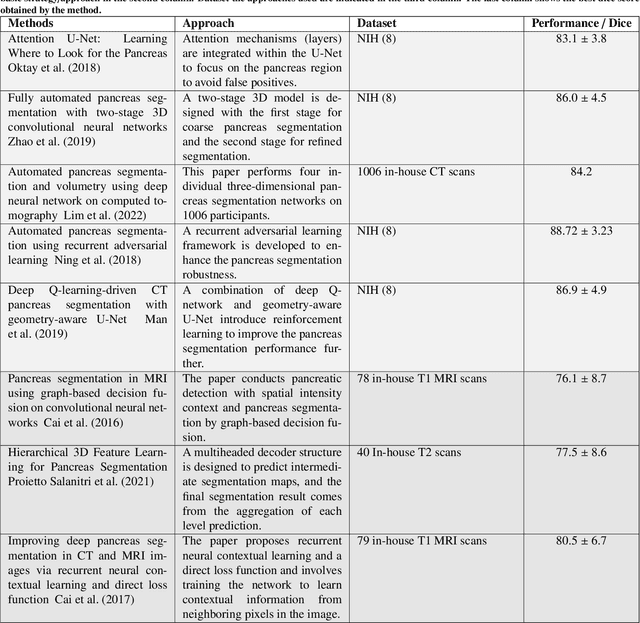
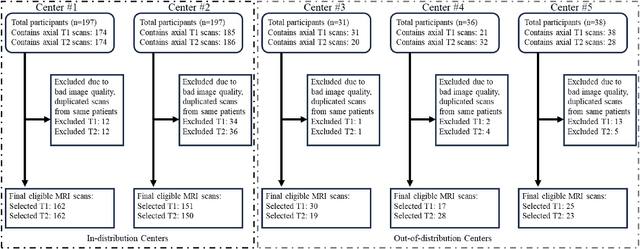
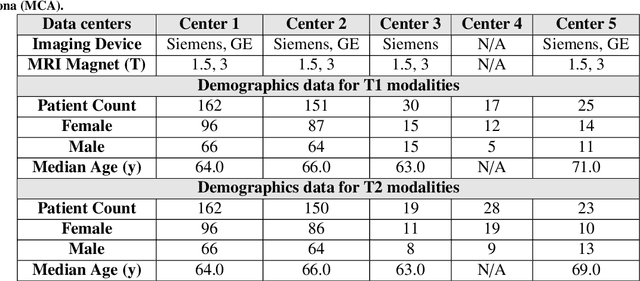
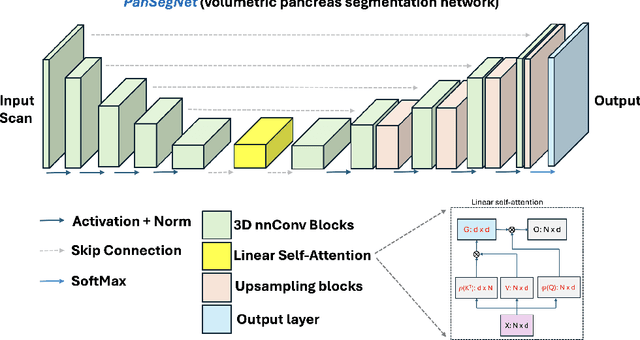
Abstract:Automated volumetric segmentation of the pancreas on cross-sectional imaging is needed for diagnosis and follow-up of pancreatic diseases. While CT-based pancreatic segmentation is more established, MRI-based segmentation methods are understudied, largely due to a lack of publicly available datasets, benchmarking research efforts, and domain-specific deep learning methods. In this retrospective study, we collected a large dataset (767 scans from 499 participants) of T1-weighted (T1W) and T2-weighted (T2W) abdominal MRI series from five centers between March 2004 and November 2022. We also collected CT scans of 1,350 patients from publicly available sources for benchmarking purposes. We developed a new pancreas segmentation method, called PanSegNet, combining the strengths of nnUNet and a Transformer network with a new linear attention module enabling volumetric computation. We tested PanSegNet's accuracy in cross-modality (a total of 2,117 scans) and cross-center settings with Dice and Hausdorff distance (HD95) evaluation metrics. We used Cohen's kappa statistics for intra and inter-rater agreement evaluation and paired t-tests for volume and Dice comparisons, respectively. For segmentation accuracy, we achieved Dice coefficients of 88.3% (std: 7.2%, at case level) with CT, 85.0% (std: 7.9%) with T1W MRI, and 86.3% (std: 6.4%) with T2W MRI. There was a high correlation for pancreas volume prediction with R^2 of 0.91, 0.84, and 0.85 for CT, T1W, and T2W, respectively. We found moderate inter-observer (0.624 and 0.638 for T1W and T2W MRI, respectively) and high intra-observer agreement scores. All MRI data is made available at https://osf.io/kysnj/. Our source code is available at https://github.com/NUBagciLab/PaNSegNet.
SalFoM: Dynamic Saliency Prediction with Video Foundation Models
Apr 03, 2024



Abstract:Recent advancements in video saliency prediction (VSP) have shown promising performance compared to the human visual system, whose emulation is the primary goal of VSP. However, current state-of-the-art models employ spatio-temporal transformers trained on limited amounts of data, hindering generalizability adaptation to downstream tasks. The benefits of vision foundation models present a potential solution to improve the VSP process. However, adapting image foundation models to the video domain presents significant challenges in modeling scene dynamics and capturing temporal information. To address these challenges, and as the first initiative to design a VSP model based on video foundation models, we introduce SalFoM, a novel encoder-decoder video transformer architecture. Our model employs UnMasked Teacher (UMT) as feature extractor and presents a heterogeneous decoder which features a locality-aware spatio-temporal transformer and integrates local and global spatio-temporal information from various perspectives to produce the final saliency map. Our qualitative and quantitative experiments on the challenging VSP benchmark datasets of DHF1K, Hollywood-2 and UCF-Sports demonstrate the superiority of our proposed model in comparison with the state-of-the-art methods.
 Add to Chrome
Add to Chrome Add to Firefox
Add to Firefox Add to Edge
Add to Edge